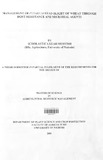| dc.description.abstract | Fusarium head blight (FHB) is a world wide disease of wheat and other small grain cereals
caused by several Fusarium species that reduce yield quantity and quality. A study covering 120
farms was done in July-November, 2008 in Nyandarua North, Imenti North and Narok districts
of Kenya to determine level of fungal genera inoculum and mycotoxin contamination. FHB
incidence was determined as the proportion of diseased heads perl OM2. Isolation of the fungus
was done from stems, heads, grains, heads and soil samples on PDA. In vitro activity of
COTAFR, FolicurR, PEARL R, Thiovit"; Epicoccum, Alternaria, Trichoderma, Penicilium was
determined by paired cultures method in completely randomized design. T -2 toxin mycotoxin
contamination in grains was determined by direct competitive Enzyme- Linked Immunosorbent
Assay (ELISA). Effect of antagonistic microorganisms, fungicides, varieties and lines on FHB
severity and mycotoxin content was tested by co inoculating Fgraminearum and Fpoae together
with each of the micro organisms, fungicides and lines.
Fusarium head blight was found to be highly prevalent with an incidence of 87 percent. Maize
was the other crop grown mostly besides wheat by up to 70 percent. DimethoateR and FolicurR
were the mostly chemicals used by up to 43 percent and 75 percent respectively. Fungal genera
isolated from wheat, wheat residues and soil were Fusarium, Trichodermai", Alternartai",
Epicoccumi" and Penicilliumi". High levels of Alternaria and Epicoccum showed low levels of
Fusarium. The major causal Fusarium species isolated from wheat, wheat residues and soil were
F stilboides, F graminearum, F poae, F heterosporum, F fusarioides, F tricinctum and F
verticilloides. Low levels of Fusarium graminearum indicated low levels of Fusarium poae.
Mycotoxin T-2 toxin detected in the grain samples of up to 23 ppb from areas that had higher
isolation rates of Epoae.
In vitro activity of fungicides had 100 percent pathogen growth inhibition. Antagonists in vitro
reduced pathogen growth up to 50 percent. In vivo activity of antagonists and fungicides did not
completely control Fusarium head blight but only reduced to low levels of up to 30 percent.
Folicur" was the most effective fungicide while Trichoderma was the most effective antagonist
in reducing disease severity. All wheat lines and varieties were susceptible to Fusarium head
blight and mycotoxin contamination thus posing a threat to human and animal health. Njoro bwl
and Njoro bw2 were less susceptible to FHB compared to Mbuni, KIBIS and Rl1 04.
Results indicated that Epoae was more prevalent in all the samples analyzed. The main causal
agents were Fpoae and Egraminearum while the major contamination was T-2 .Integration of
crop rotation, cultural, microbial agents, fungicides and host resistance could be used to manage
the disease. Planting of less susceptible varieties to FHB and also use of FolicurR in management
of FHB. Field trial of the fungicides and microbial agents in the management of FHB should be
undertaken. | en |

